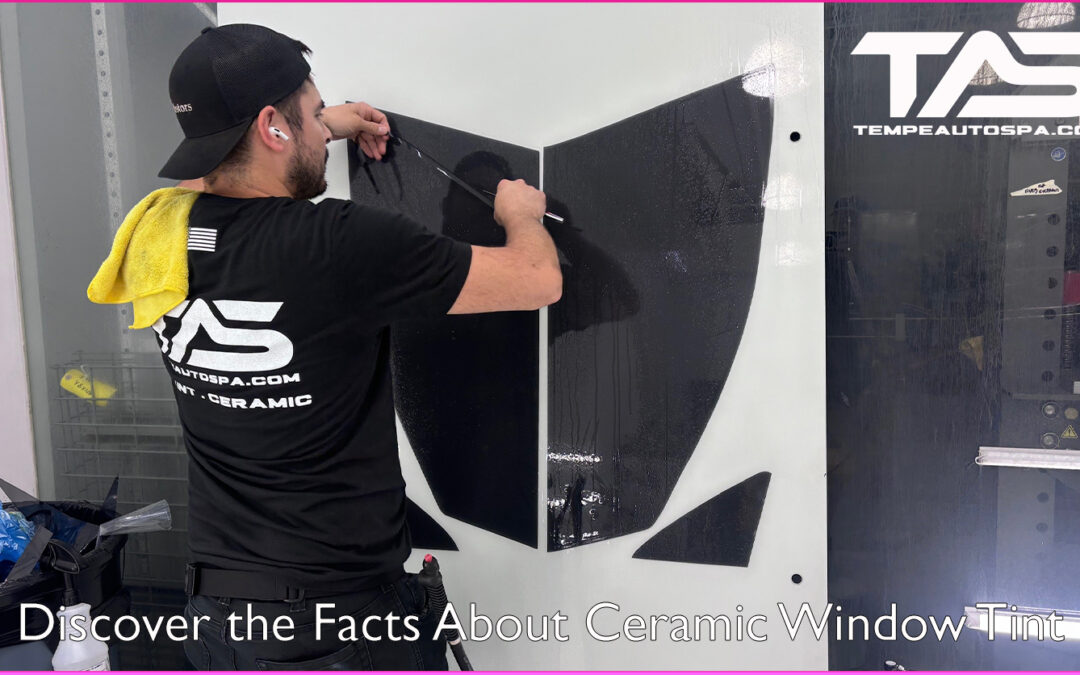Discover the Magic of Ceramic Window Tint for Your Car
If you’ve spent any time in Arizona, you know just how intense the sun can be. For car enthusiasts and vehicle owners in Tempe, Scottsdale, and Phoenix, finding ways to protect both your vehicle and its occupants from the relentless heat is essential.
Enter ceramic window tinting—a game-changer in the world of automotive care. Ceramic window film is not just the hottest new trend in tint products. It’s the world’s first Luxury Window Film. The combination of industry-leading heat rejection – and superior optical clarity makes this tint the choice of most Phoenix area car, truck, and SUV owners.
Plus – the fact that it does not block cell phone signals like some other film types, and its availability in multiple VLTs or shades, makes this tint an exceptional investment.
In this article, we will explore several key facts about ceramic window tinting for cars, detailing its benefits, and features, and why it’s worth considering for your vehicle.
Advantages and Benefits of Ceramic Tint over Traditional Films
Traditional window tints have served their purpose for years, but they come with limitations. Ceramic window tint, however, offers a host of advantages that make it a superior choice.
Superior Heat Rejection: Ceramic tints can block up to 70% of solar heat without compromising visibility. Plus, this type of film also absorbs up to 98% of infrared radiation or IR from the sun. This means your car’s interior remains cooler, reducing the need for air conditioning and improving fuel efficiency and battery range for EVs.
UV Protection: One of the standout features of ceramic tint is its ability to block nearly 99% of the sun’s harmful UV rays. This not only protects your skin but also prevents your car’s interior from fading and cracking over time.
Enhanced Durability: Unlike traditional films that can bubble or discolor over time, ceramic tints are incredibly durable. They maintain their appearance and effectiveness for years, making them a long-term solution for sun protection.
Key Features of Ceramic Tinting, including Heat and UV Rejection Rates
When it comes to window tinting, not all films are created equally. Ceramic tints boast several key features that make them an attractive option for car owners.
Lifetime Warranties: Older and lower grade window films have a difficult time holding up to the extreme temperatures of Arizona living. This isn’t the case with high-quality ceramic films – like KAVACA Ceramic IR and Ultimate IR. The nanoceramic particles infused in the adhesive and the film layers strengthen the film – allowing it to hold up for decades.
Glare Reduction: Driving in bright sunlight can be dangerous due to glare. Ceramic tints significantly reduce glare, enhancing visibility and safety on the road. This feature is particularly beneficial for luxury car owners who prioritize both style and safety.
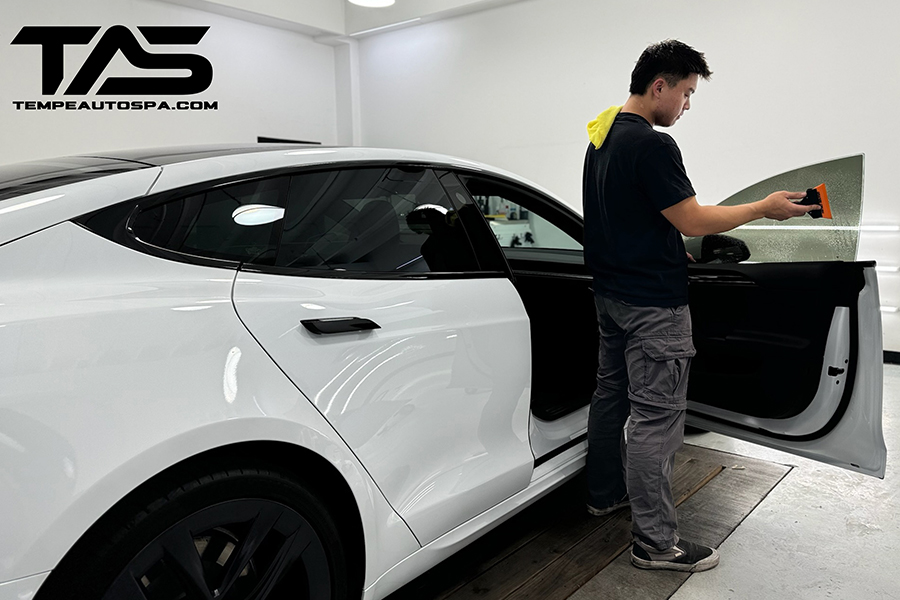
A Comparative Analysis of Ceramic Tinting with Other Tinting Options
Choosing the right window tint involves understanding the differences between available options. Here’s how ceramic tinting stacks up against other common types:
Dyed Tint: Dyed tints are the most affordable option but offer the least protection. They primarily reduce glare and improve privacy but don’t effectively block heat or UV rays.
Metallic Tint: Metallic tints provide better heat rejection than dyed tints but can interfere with electronic devices and signal reception. They also have a shiny appearance that some car owners might not prefer.
Ceramic Tint: Ceramic tints offer the best of both worlds—excellent heat rejection and UV protection without compromising signal reception or appearance. They maintain a sleek, non-reflective look that complements any vehicle.
Learning Window Tint Lingo
Understanding the terminology used in the window tinting industry can help you make an informed decision.
VLT (Visible Light Transmission): This refers to the percentage of visible light that passes through the tint. Lower VLT means darker tint. For example, although they appear to be 100% clear – factory automotive glass has VLT ratings between 70 and 85%.
TSER (Total Solar Energy Rejected): This measures the total amount of solar energy that the tint rejects. Higher TSER indicates better heat rejection.
IR Rejection: This refers to the tint’s ability to block infrared radiation from entering the vehicle’s interior, which is a significant component of solar heat. The higher the IR rejection percentage, the more heat rejection produces – and the cooler your vehicle will maintain.
So, when you’re investigating and researching window film for Arizona living, it’s best to pick the one that offers the highest TSER ratings across its line-up of different VLTs. It’s also vital to choose a VLT percentage that complies with our State of Arizona window tint laws.
Arizona permits vehicle owners to apply window film to the inside of automotive glass – however, the percentages depend on the location. Front doors are restricted to 33% VLT – while you can go as dark as you’d like on rear windows and doors.
In general, the darker the film (or lower the VLT rating) the higher the TSER and IR Rejection. So, if you’re restricted on VLT percentage – or don’t want to darken your glass – pick a film like Ceramic Pro Ultimate IR or Ceramic IR that has high TESR and VLT ratings – even on lighter shades.
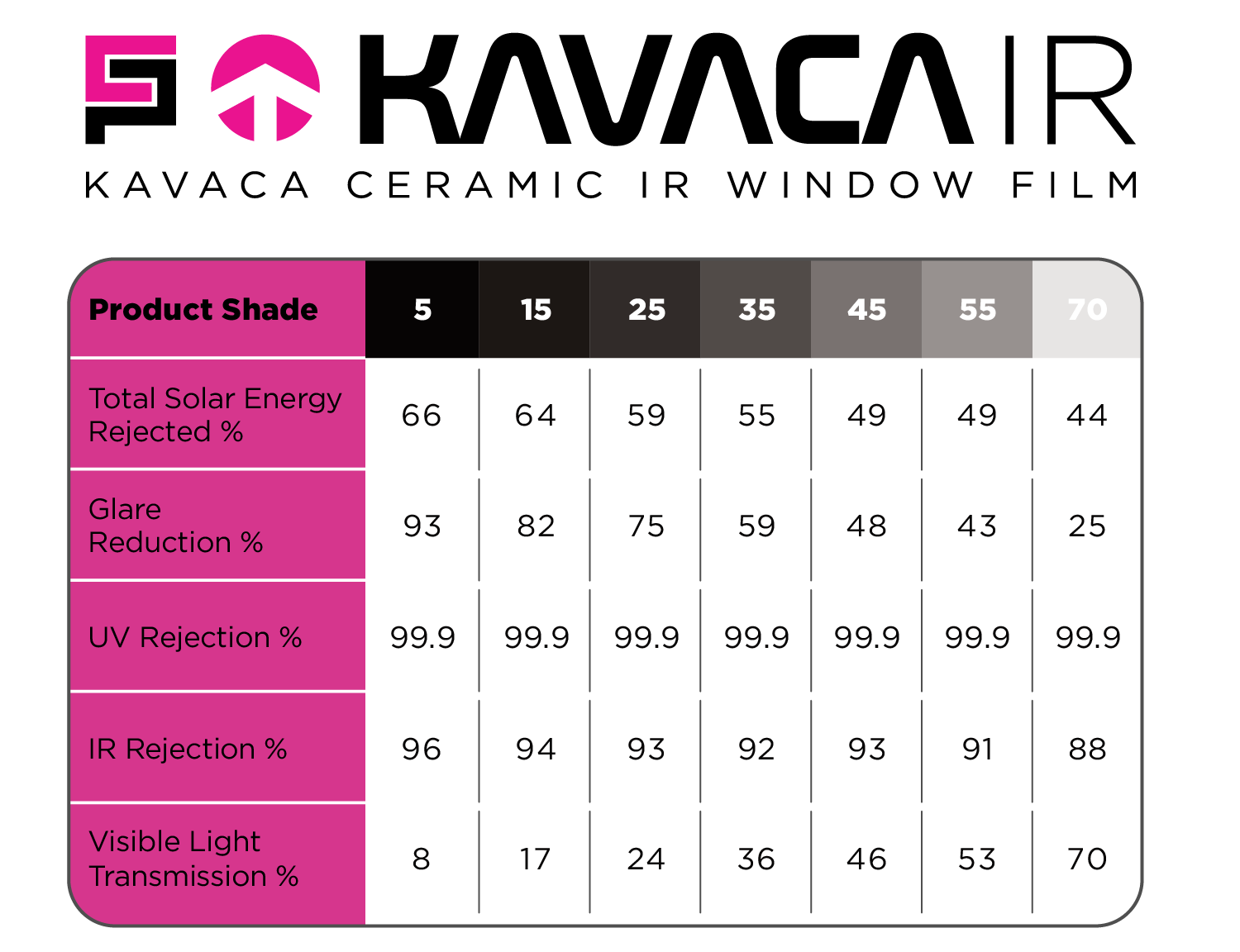
The Cost of Ceramic Tinting: Is It Worth the Investment?
Investing in ceramic window tinting might seem like a significant expense, but it’s essential to weigh the costs against the benefits.
Initial Cost: Ceramic tinting can be more expensive than other types of tints. However, its durability and long-term benefits often justify the higher price.
Long-Term Savings: By reducing the need for air conditioning, ceramic tinting can improve your car’s fuel efficiency. Additionally, protecting your car’s interior from UV damage can save you money on repairs and replacements.
Resale Value: High-quality tinting can enhance your car’s resale value. Prospective buyers often appreciate the added benefits of ceramic tinting, making your vehicle more attractive in the market.
The Process of Installing Ceramic Window Film Correctly
While ceramic window film is the next-generation tint that most Arizona vehicle owners are choosing, it doesn’t install itself. Process matters – especially when it comes to prep work, using the right techniques, and quality assurance.
Here at our detailing company, we follow a multiple-step process to ensure that all window tint installations are completed successfully. Let’s review our process for installing ceramic tints in Maricopa County.
Step 1 – Full Exterior Car Wash
We take a lot of pride in the cleanliness of our Tempe Auto Spa. Before any vehicle enters our facility – our detailers give it a thorough exterior car washing. This not only removes any debris – and preps the vehicle for service, but it’s also one small way we go the extra mile for our clients – regardless of the service we are providing.
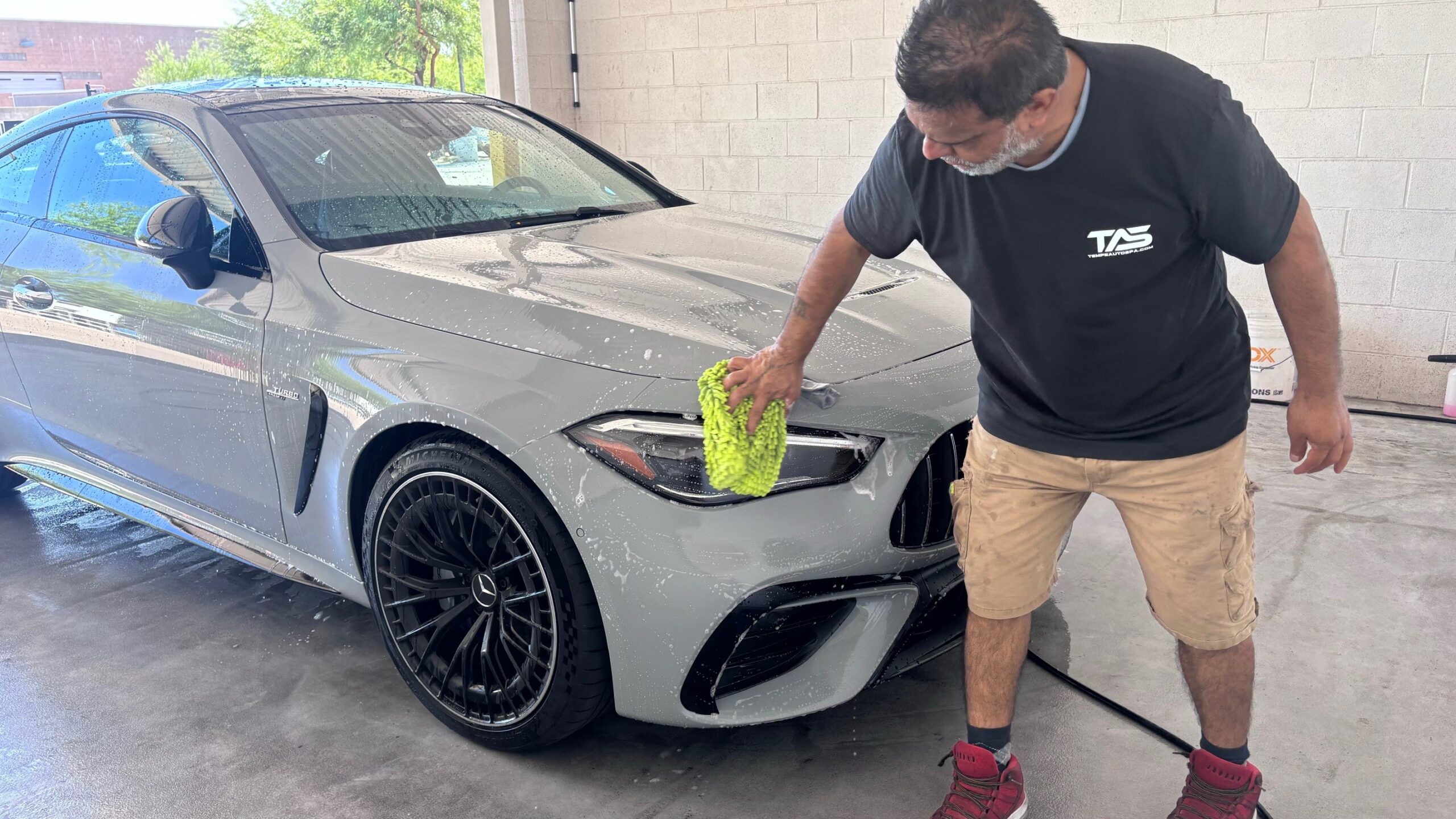
Step 2 – Protect the Interior
Installing window film involves the use of a lot of ‘slip solution’ – which is essentially soapy water. The solution allows the window film to float on the inside of the window – permitting the technician to precisely fit it before tacking it on.
As the window tint is tacked, a lot of standing water will spill onto the door panel. To avoid any water damage, we first install a protective wrap.
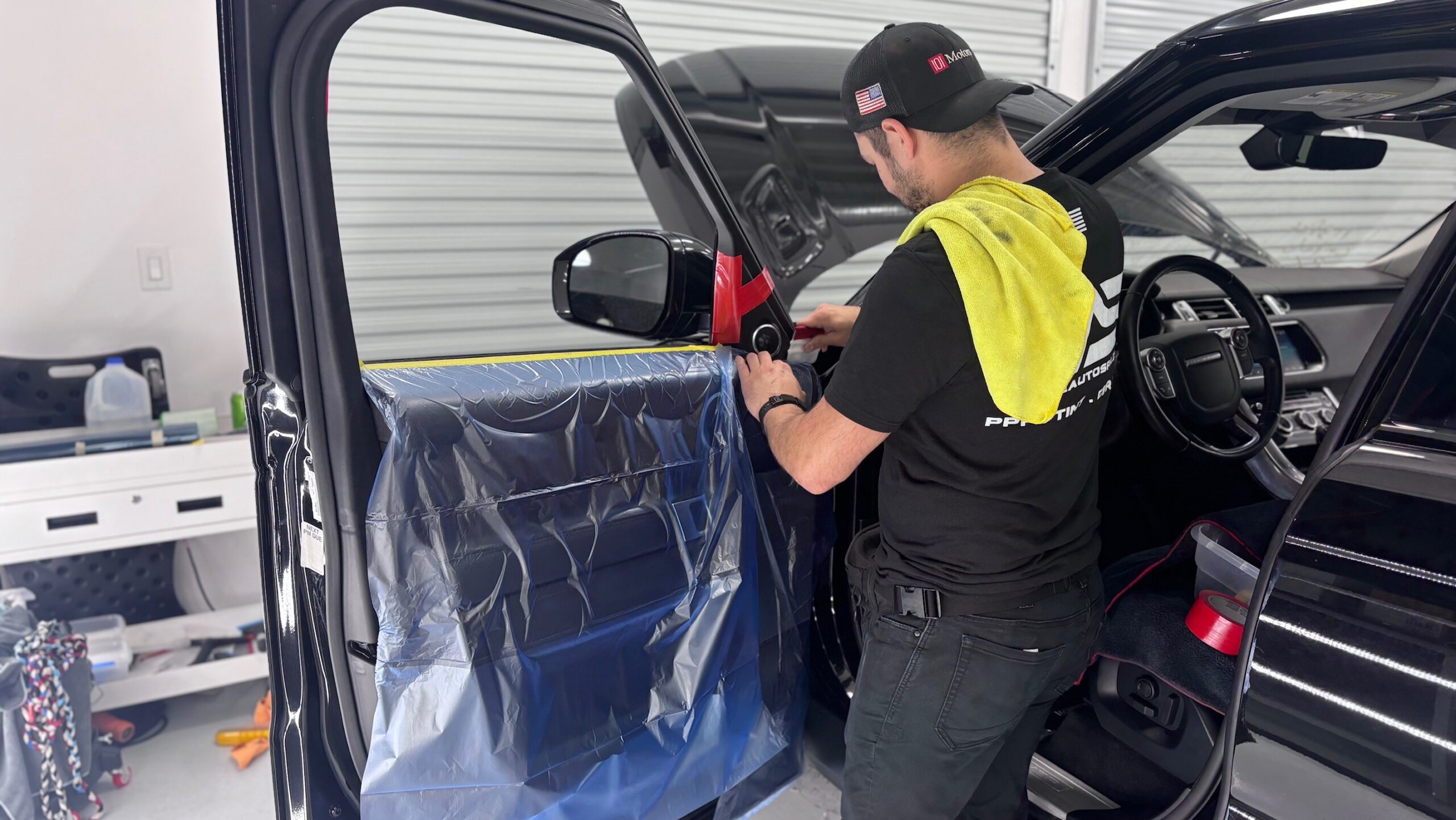
Step 3 – Window Decontamination
Although washing the exterior is a critical first step to our window tint installation, it doesn’t remove embedded debris on the glass. To ensure that your ceramic window tint is installed with the best chances of clean bonding, we complete an interior and exterior glass detailing process.
This involves the use of multiple products and steps.
Exterior Glass Cleaning
One of the most important steps of installing window film is shrinking. This involves the use of heat to shrink the film for a precision fit. It’s done on the outside of the glass where the film is being installed.
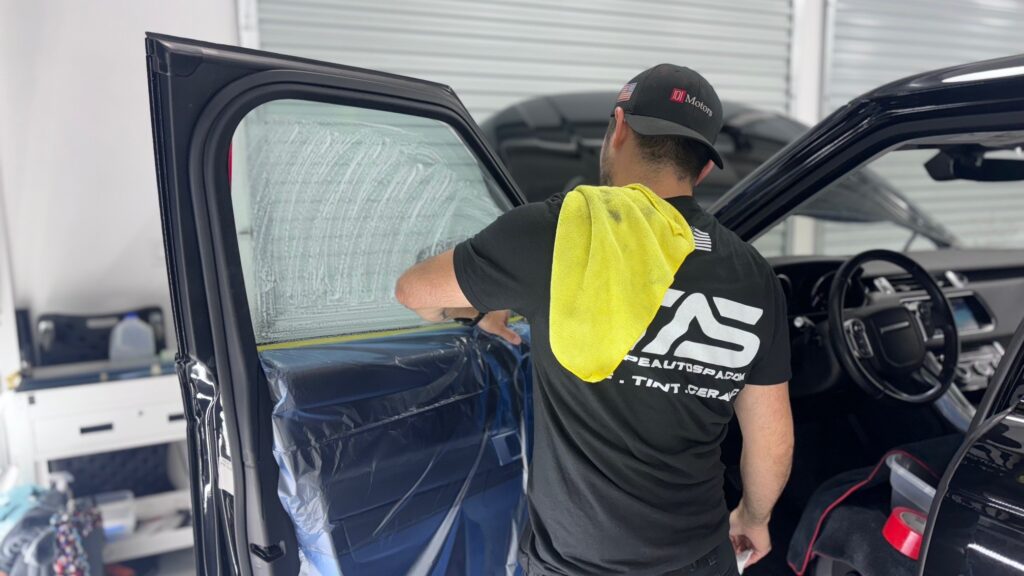
To ensure that the film does not get contaminated, we use cleaning pads and microfiber towels for fully clean the exterior prior to shrinking.
Interior Glass Cleaning
Since we don’t want any debris to be trapped between the film and glass, we continue with decontamination on the inside of the glass as well. This leaves a surgically clean surface – ready for ceramic tint installation.
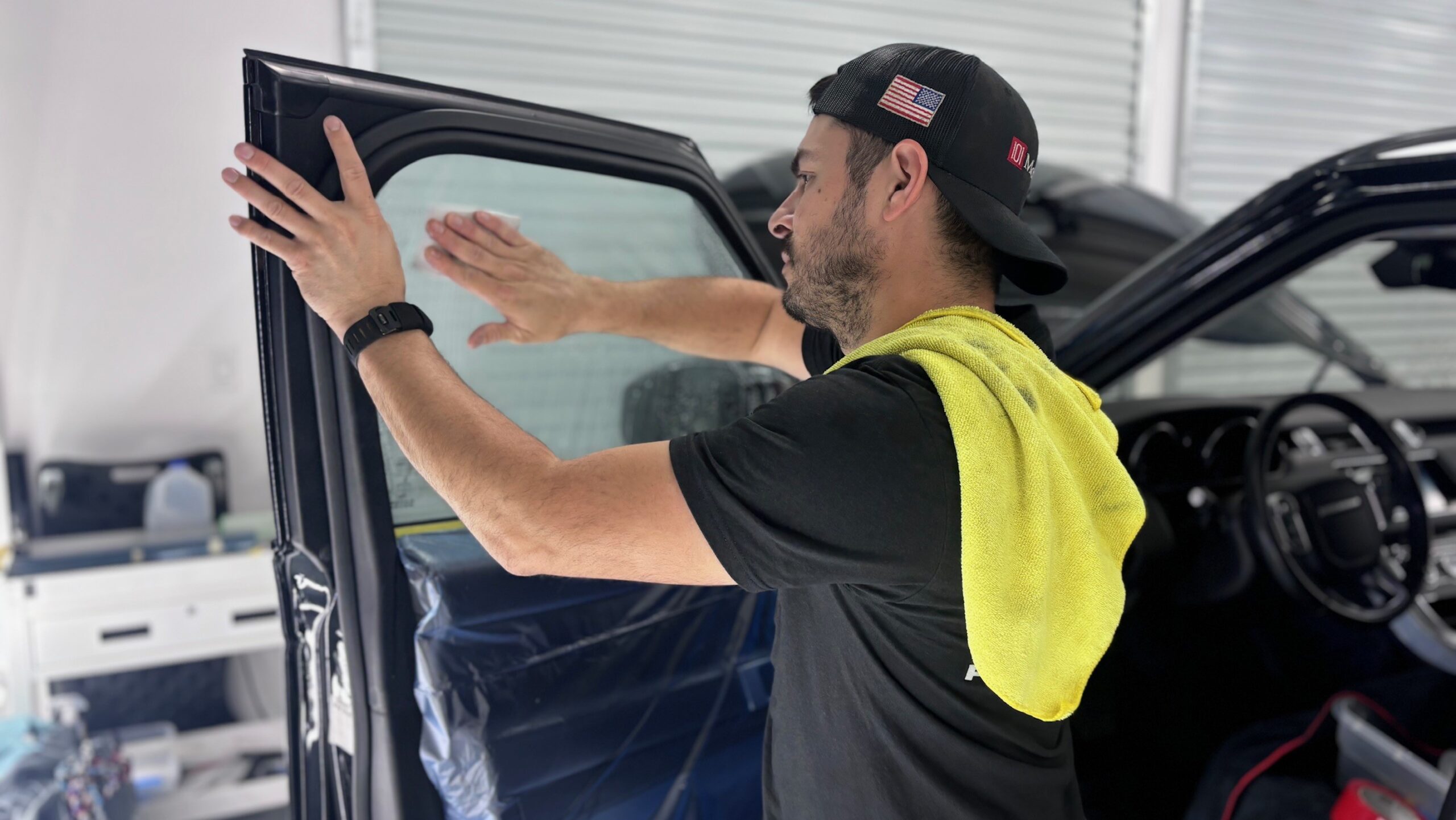
Step 4 – Computer Cut Window Film
Contrary to belief, not all automotive glass is identically shaped. To ensure that every vehicle’s window tint installation is precision fit, we begin with computer cut window patterns. Each vehicle’s window patterns are cut using a plotter. This helps us to reduce the volume of film used – which also keeps our costs down – which we pass along to our clients.
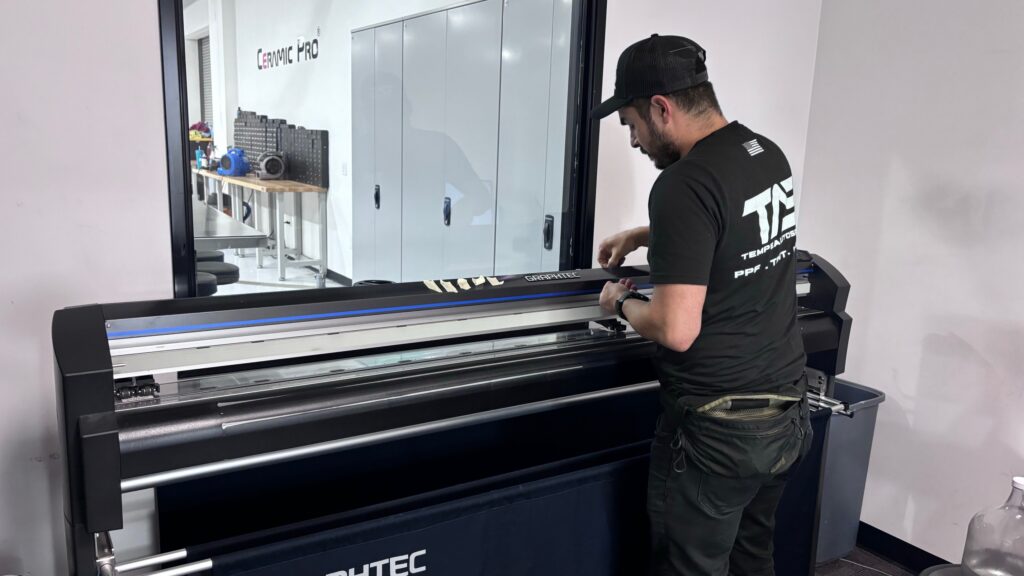
Step 5 – Window Film Weeding
While computer cutting is precise – it’s not 100% perfect. To ensure the film is exactly fit, professional window film installers will ‘weed’ the film – before installing on glass. Weeding involves removing the excess tint material from the edges and any cutouts.
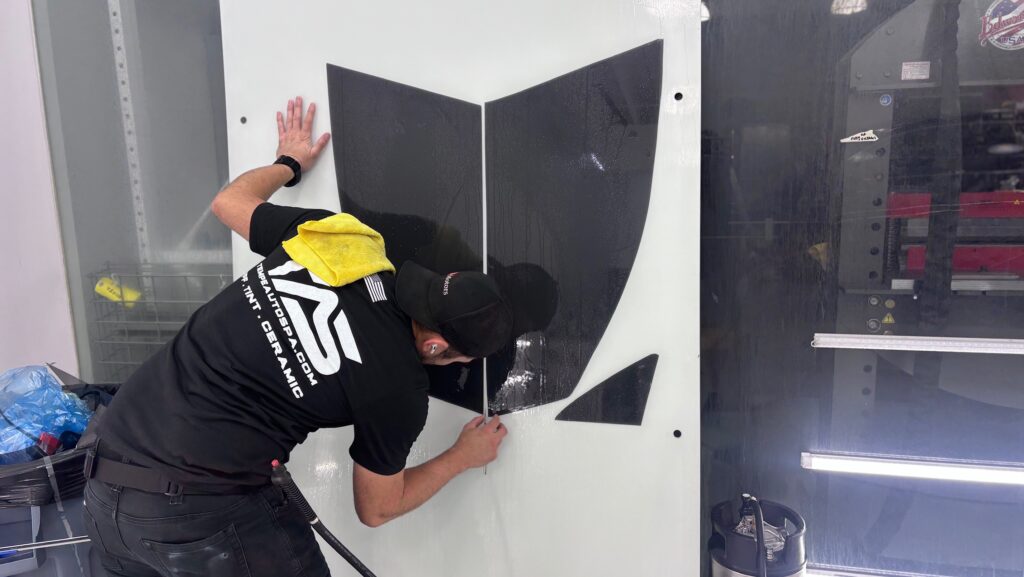
This is done to ensure that only the desired portions of the tint remain on the window. It’s a bit like peeling away the extra parts of a sticker to leave just the design you want. Weeding helps in achieving a precise and clean finish, ensuring the tint looks professional and performs well.
At some window tint installers, the technician will complete this on the automotive glass. We strongly oppose this approach, as it opens the door to scratching the glass or worse, cutting or damaging window trim.
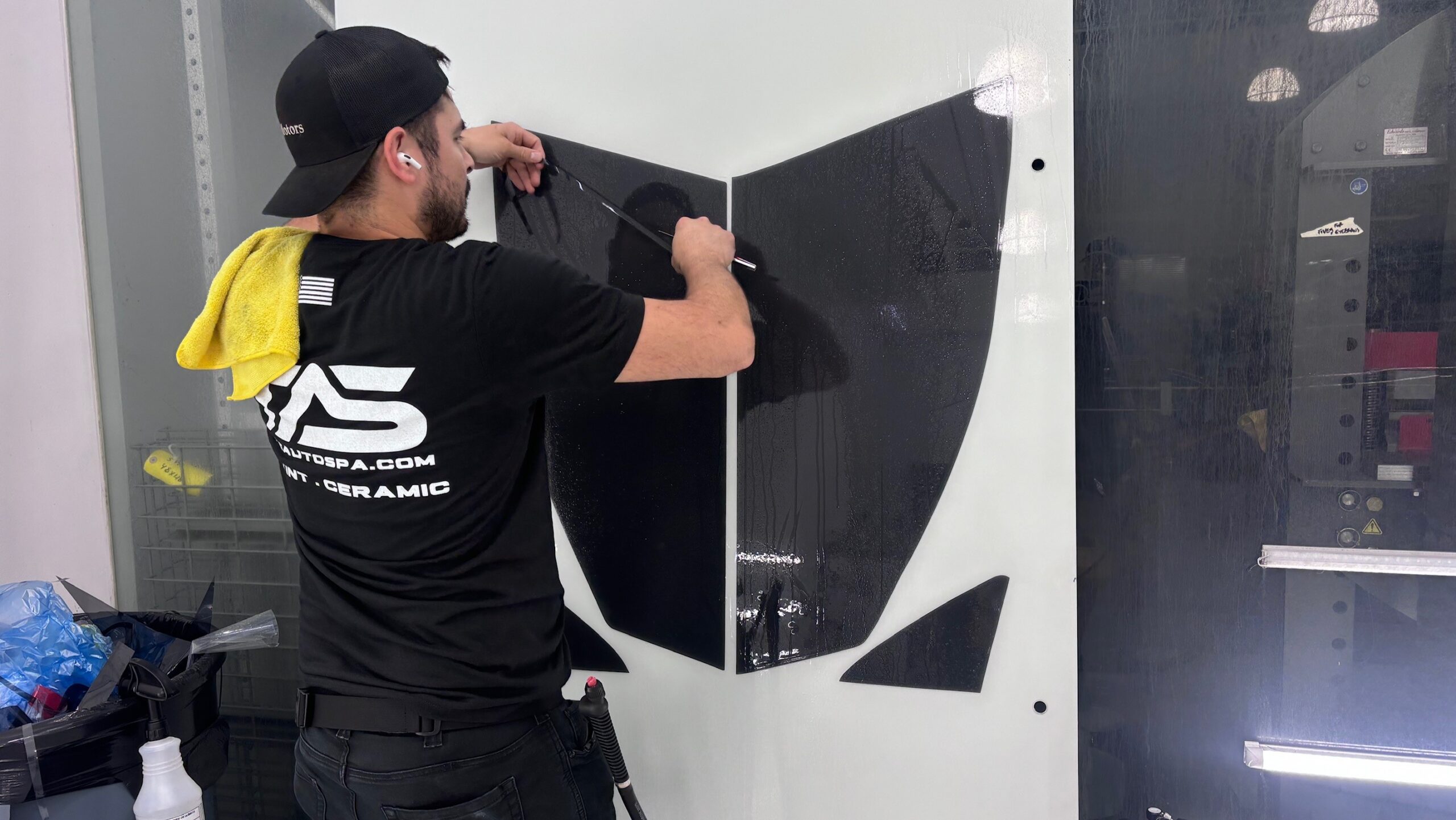
Step 6 – Shrinking
Right before the tint is installed to the inside of the glass, our technicians will use a heat gun to shrink the film. This ensures that the window film is tight, straight, and smooth – for a more seamless installation.
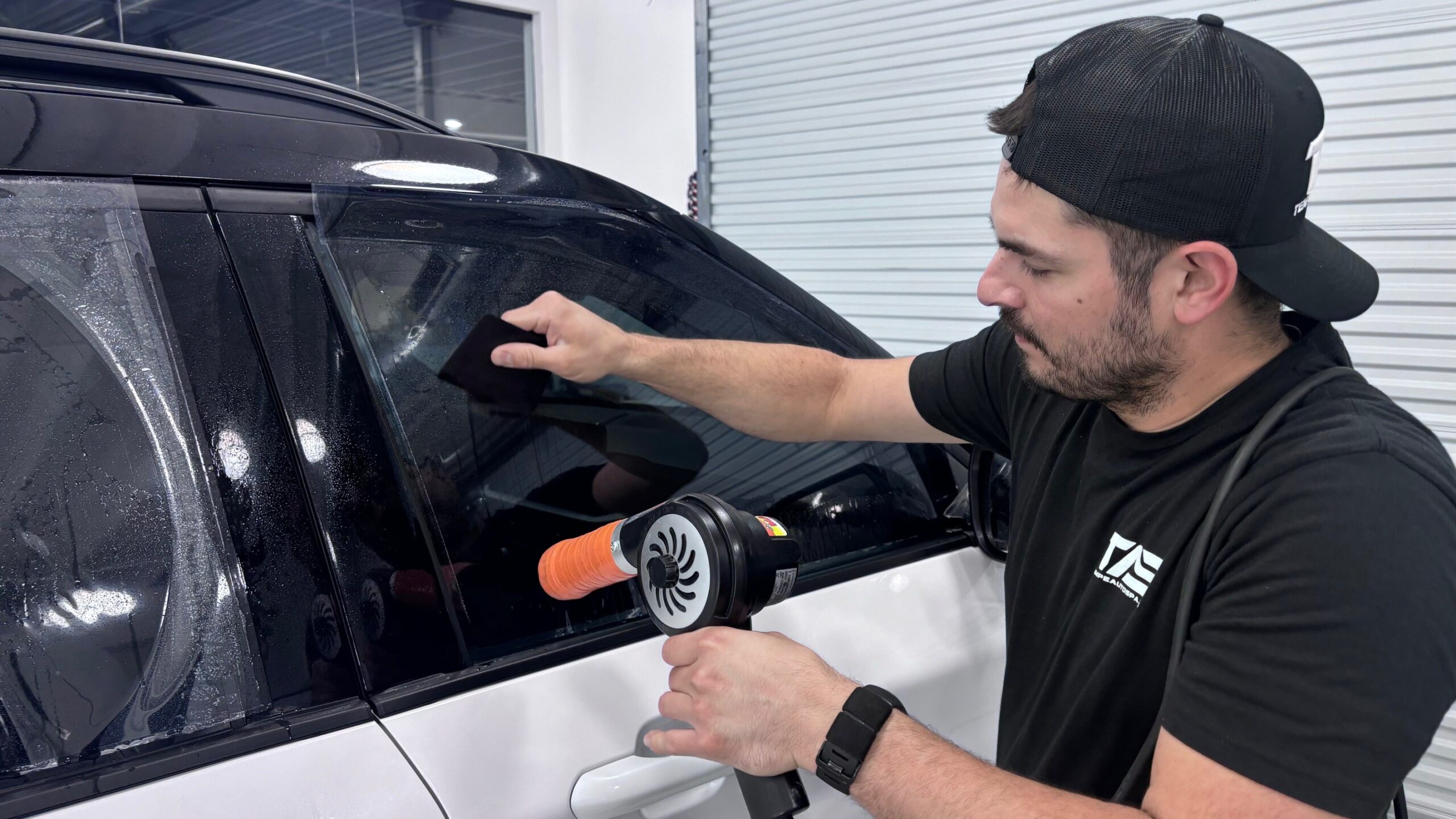
Step 7 – Tacking the Film
As the film is installed, the tinters will use a lot of slip solution to correctly fit the film onto the desired sections of the glass. When the film is perfectly aligned, they will tack the film by using a squeegee – which removes the standing slip solution, activates the adhesive, and allows the film to bond cleanly to the glass.
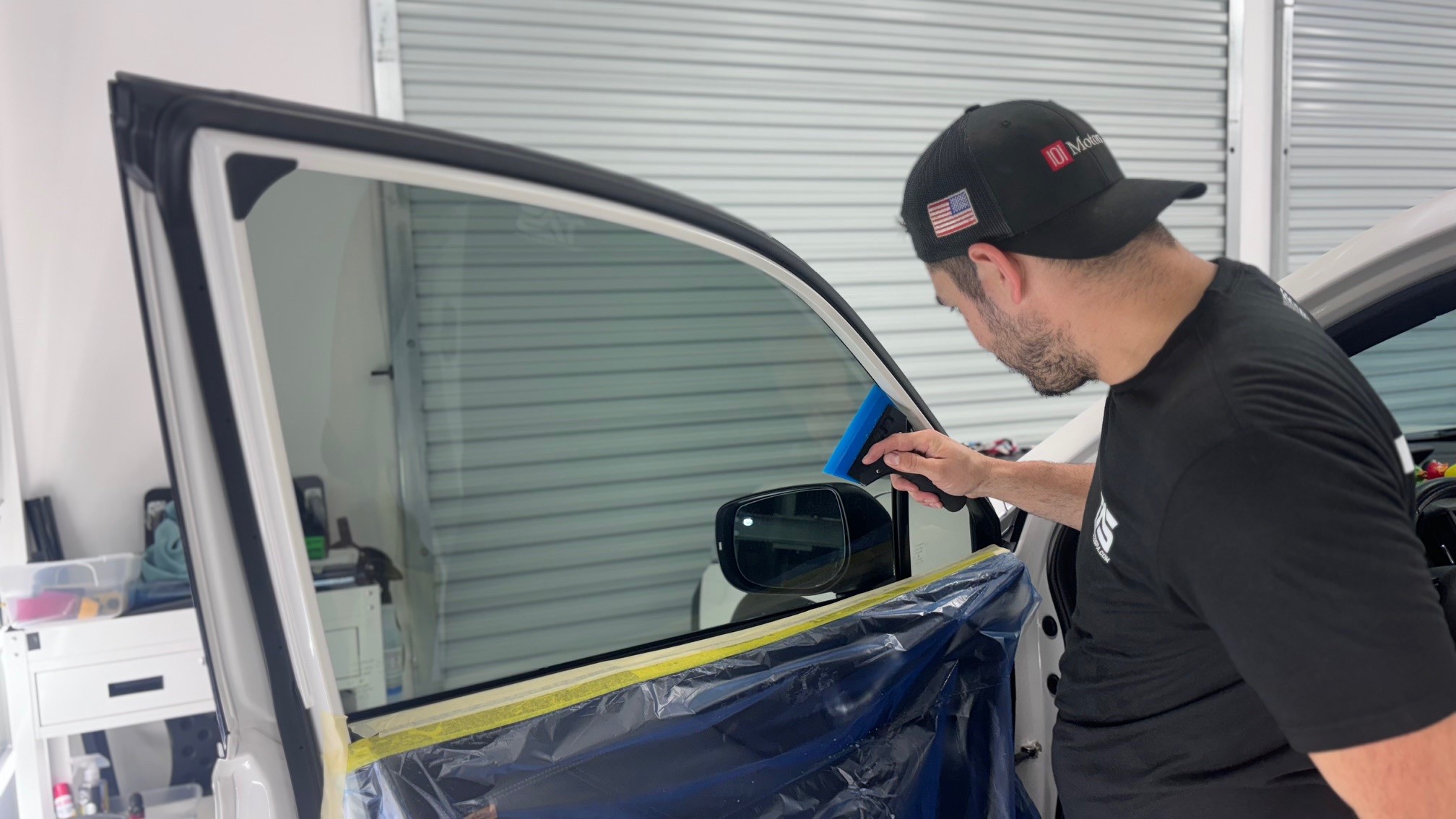
Step 8 – Precision Fitting
Many windows have tight fitting areas that require an experts touch to ensure perfect installation. Our technicians use specialized tools to precision tuck film in tight cracks or sections of the glass. This helps to reduce the potential of tiny bubbles occurring during the drying process.
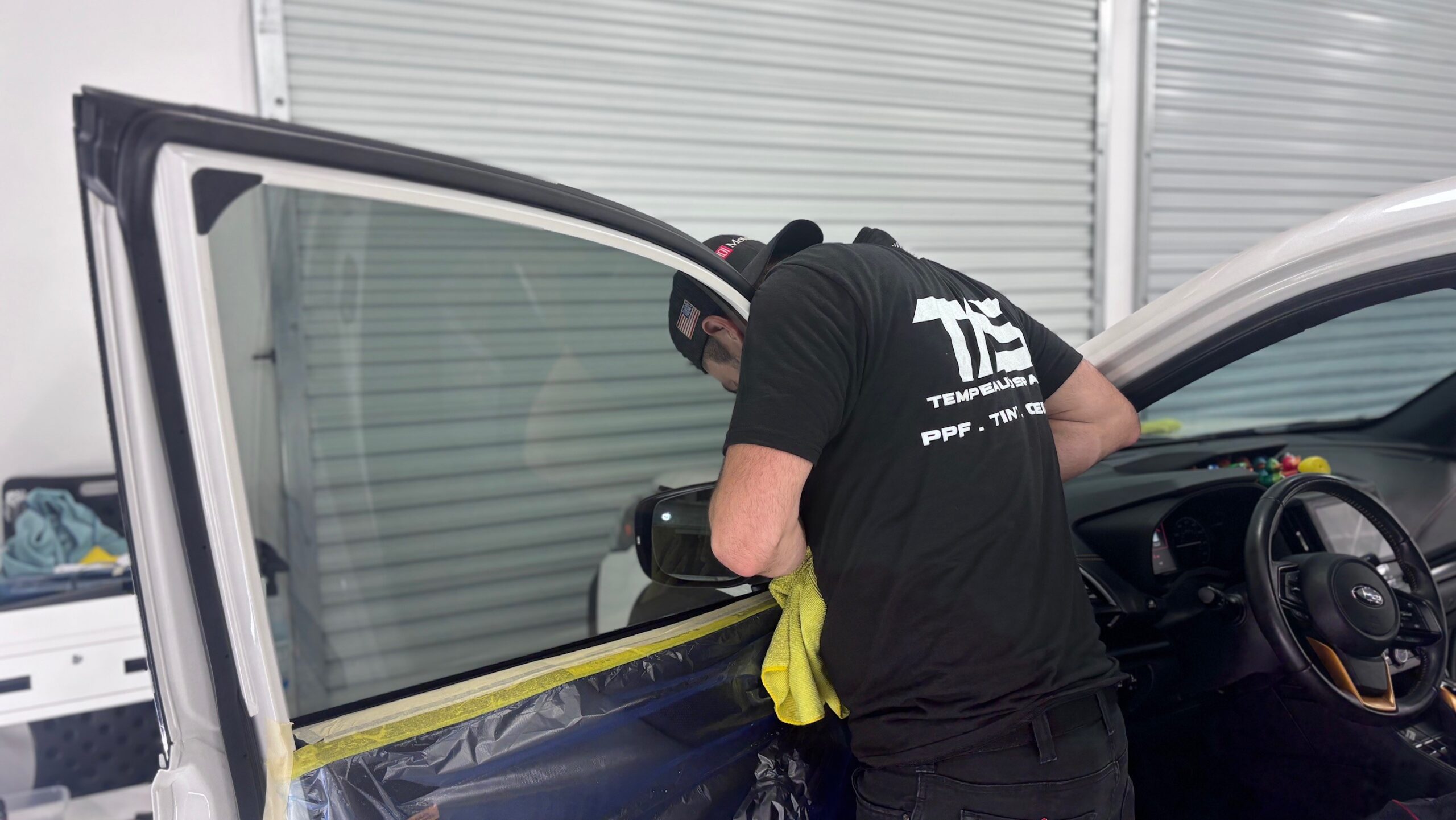
Step 9 – Final Wipe Down & Drying
After the film installation is complete, our technicians will wipe down the entire door and interior sections – to remove any liquid from the installation area. We then keep the vehicle in a temperature-controlled area for a few hours to allow the adhesive to initially cure.
As a part of our quality control process, once the initial curing has been completed, our technicians will do a final visual inspection for any imperfections, creases, or bubbles before releasing the vehicle back to our clients.
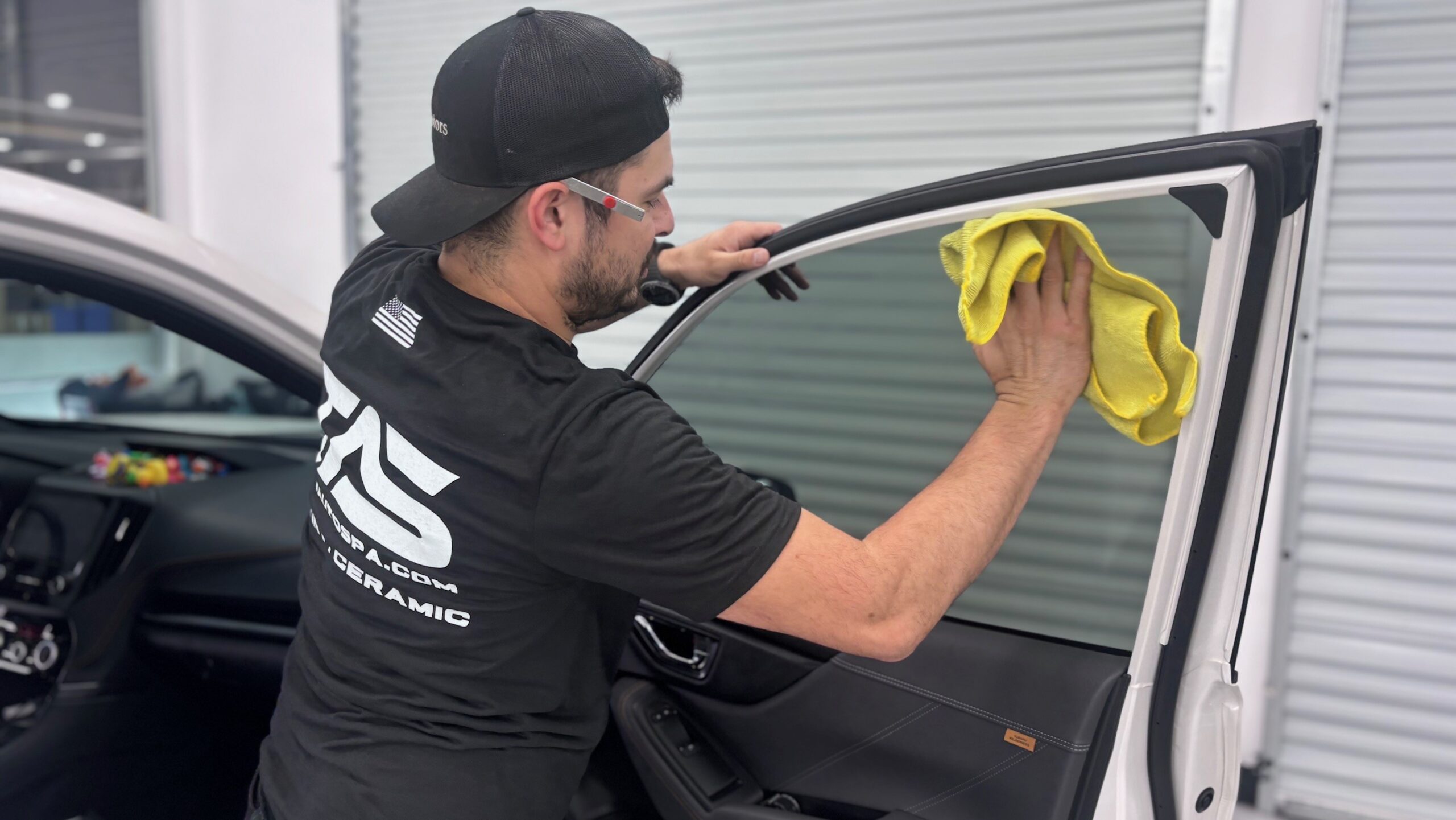
Maintenance and Care Tips for Ceramic Tint to Ensure Longevity
To ensure your ceramic tint lasts as long as possible, proper maintenance is key.
Avoid Abrasive Cleaners: Use a soft cloth and mild cleaner to clean your windows. Avoid ammonia-based products as they can damage the tint.
Be Gentle: When rolling down your windows, ensure the tint has fully cured (usually a few days after installation). This prevents peeling or scratching.
Regular Inspections: Periodically check for any signs of bubbling or peeling. Addressing minor issues promptly can prevent them from becoming significant problems.
Where to Get Quality Ceramic Tinting in Phoenix
Finding a reliable provider for ceramic window tinting is crucial for achieving the best results.
Research and Reviews: Look for businesses with positive customer reviews and a solid reputation. Websites like Yelp and Google Reviews can provide valuable insights.
Experience and Expertise: Choose a provider with experience in installing ceramic tints. Skilled technicians ensure that the tint is applied correctly, maximizing its effectiveness.
Warranty and Support: Select a business that offers a warranty on their work. This provides peace of mind and ensures that any issues are addressed promptly.
Wrapping it Up
Ceramic window tinting offers a multitude of benefits for car enthusiasts and owners in Tempe, Scottsdale, and Phoenix. From superior heat rejection and UV protection to enhanced durability and aesthetic appeal, ceramic tints are an investment worth considering.
Whether you’re looking to improve your driving comfort, protect your car’s interior, or simply enjoy a cooler ride, ceramic window tinting is a solution that delivers on all fronts.
Ready to take the next step? Contact the expert ceramic window tinters at The Tempe Auto Spa @ 101 Motors. Our tinters have years of experience installing advanced window films. They take pride in paying attention to the small details that help to reduce bubbles or debris trapped between the film and the glass.
At our Ceramic Pro Elite Dealer in Tempe, we exclusively offer Luxury Window Film that delivers industry-leading optical clarity, TESR, and IR rejecting ratings and is offered in multiple shades.
This permits you to select a shade that fits your aesthetic appeal and keeps you and your vehicle occupants protected from the blazing Arizona sun.
If you’d like to receive a FREE QUOTE for ceramic window tint installation in Maricopa County, please fill out the form. Our team will be in contact with you quickly.

